Check out this post — Expense Report: Pre-Trip Costs — for a better understanding of other costs associated with a RTW trip, as well as a definition of my travel style and how it impacts my budget.
I’m thrilled to share this expense report because the numbers are significantly lower than anywhere else I’ve traveled so far.
Here’s what I spent in U.S. dollars over 24 nights / 25 days in Indonesia:
- Accommodation = $415.49 … $17.31 per night
- Food = $251.45 … $10.47 per day
- Groceries = $38.17 … $1.59 per day
- Coffee = $16.76 … $.70 per day
- Activities = $271.88 … $11.32 per day
- Cell & Wifi = $19.17 … $.80 per day
- Transportation = $133.97 … $5.58 per day
- Miscellaneous = $85.36 … $3.55 per day
And the grand total for 24 nights in Indonesia is…:
$1,232.30 USD, which works out to $51.34 per day.
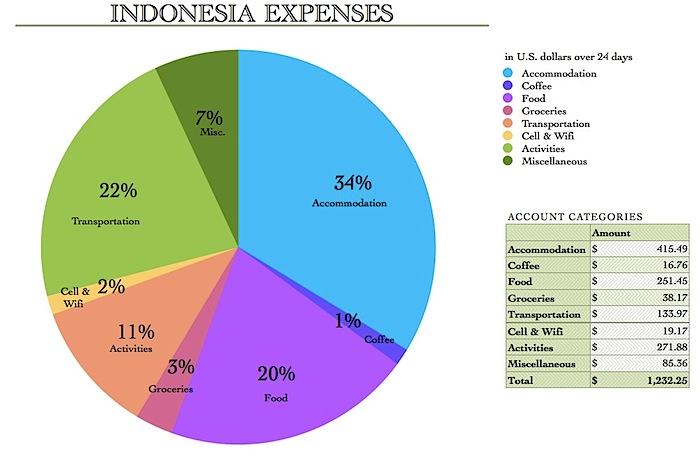
I am thrilled about those numbers!
Here’s how they compare with other countries I’ve traveled to:
- My daily average in Cook Islands: $157.05
- My daily average in New Zealand: $88.56
- My daily average in Australia: $83.37
- My daily average in Singapore: $78.86
- My daily average in Indonesia: $51.34
When you can stay in a hotel like the one below and still live on $51 a day, I say don’t over think it — go to Bali for a budget-friendly vacation.
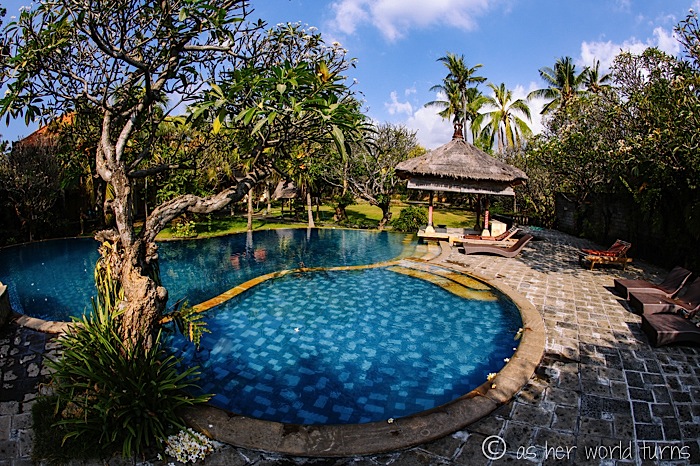
A few notes:
- I used xe.com in late August to calculate the exchange rate and at that point in time, 1 IDR (Indonesian Rupee) = .0000892 USD.
- I did not receive any blog discounts while traveling through this country, so these numbers are accurate to what a flashpacker might spend visiting this part of the world.
- I did not include my flights into or out of Indonesia, since I will note international flights on a separate RTW airfare budget at the end of my trip.
- For a few dollars, I purchased a SIM card from XL and added credit as needed. It was a pain to add credit — I had to seek out a shop (or sometimes just a person) who would text something from THEIR phone and then within minutes I’d get an official text confirmation that credit had been added to my number. REALLY annoying, but I find a data plan necessary to help with navigation (and, if I’m being honest, Instagram). I continue to use the Viber app to communicate for free with my friends and family back home.
- I’ll mention it again here since it’s relevant — I continue to use my Charles Schwab debit card to avoid international ATM fees.
- I have yet to buy a single souvenir on this trip. (*pats self on back*)
- Some of the miscellaneous items I purchased include: visa on arrival ($25 USD), departure tax ($10), bug spray and toiletries ($18), vinegar and baking soda to remove the sulfur smell from my clothes after exploring Ijen Crater ($11), postcards and stamps ($10), and a $10 train ticket from Kuala Lumpur to Singapore to show proof of onward travel (a requirement of entry into Malaysia, my next country)*
* This is an unwieldy explanation, but here goes… For certain countries, airlines require proof of onward travel before they’ll allow you to board the plane. When I departed LAX on a 1-way ticket to the Cook Islands / New Zealand, I had to show proof of my onward travel (to Australia) — because New Zealand requires it. Australia does not. Most people purchase round-trip tickets so this isn’t an issue for them, but during long-term travel it’s more common to buy 1-way tickets and some countries are picky about wanting to see proof that you plan to depart. In this instance, I never intended to use the $10 train ticket from Kuala Lumpur to Singapore, it was just a cheap way to offer proof if the airline in Lombok gave me any trouble for flying to Malaysia on a 1-way ticket. Turns out they never asked. You can also doctor an old ticket by copying & pasting it into a word document and then changing the dates / departure cities… and then it won’t cost you anything. I’ve worked up the courage to do this more recently in other countries and saved the fake document as a screen grab on my iPhone. The airline employee at check-in usually gives it a cursory glance; as long as it looks legit there are no further questions. The burden of checking for onward travel falls on the airline because they are responsible for transporting you back to where you came from if the country you’re traveling to denies you entry (of course the airline would then pass that cost onto the passenger in question, but the initial expense falls upon the airline). In the case of entering Malaysia, I just paid $10 for a train e-ticket and was ready to show it on my iPhone if anyone asked for proof of onward travel. But whether you have a legit ticket or a fake one, it’s up to the passenger not to overstay the maximum number of days allowed per each country’s specific visa rules.
I hope that this has been informative for anyone planning their own trip to this part of the world! As this data demonstrates, Indonesia is supremely budget-friendly and, in the case of certain Bali resorts, a high value destination.

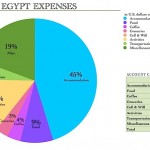
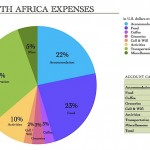
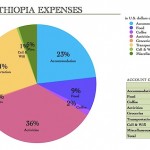
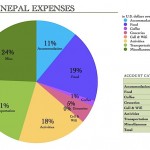
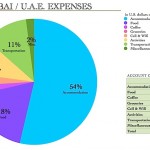

That whole onward travel ticket thing is so interesting!
Right?! It’s not much of an issue if you’re flying round-trip, but with all the one-way flights I bought I had to be careful. I think it’s funny how easily the airlines accept a doctored ticket. After awhile I stopped being nervous about it!
Very nice review of places Erica , I was searching for jelly fish lake information and stumbled on to ur blog. Very informative blog, So read some of the reviews of places i plan to visit in my near future. Wanted to comment and encourage you to visit more beautiful places this world has and put in smiles/encourage to travelers like me by writing ur experience in your blog.
Good luck and happy weekend
Thank you so much for the kind words! Best of luck in your future travels!